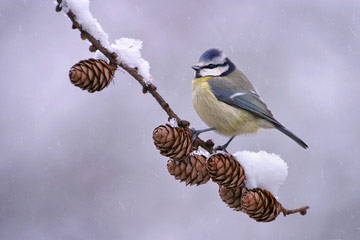
Blue Tit © Ben Hall
There is little difference in the breeding season and winter distribution of Blue Tits in the county. Odd birds occasionally make it to Hilbre, and also into the highest eastern hills, but not the estuarine saltmarshes. Blue Tits’ habitat use is similar in winter, with most records in woodland and human sites, but there are significant drops in birds reported from scrub (5% of records in winter, 8% during the breeding season) and farmland (8% of records in winter, 13% during the breeding season), with more birds found in farmland hedges (26% of records in winter, 12% during the breeding season).
In natural woodlands, Blue Tits spend most of their time in winter in oaks, searching for insect food amongst the leaves and dead branches, increasingly turning to examining buds when they appear. Beechmast is an important seed, if present, and in gardens they eat peanuts, sunflower and other seeds, bread, suet and other fats. Their former habit – known in Cheshire in the 1930s (Boyd 1946) – of pecking the tops from milk-bottles and drinking the cream is seldom reported these days.
Many writers have had nothing to say about wintering Blue Tits, Coward (1910) and Bell (1962) amongst them, and for many years the annual county bird reports describe only their autumn coastal passage. A detailed study of a relatively small population in suburban Birmingham (Kenrick 1940), which ought to be repeated today, found four components to the population. About 38% of birds were resident, breeding in local nestboxes and visiting bird tables in winter. A further 12% were summer visitors, seen in successive years but only when breeding. Another one-quarter were winter visitors, seen in successive winters but not during the breeding season, and one-quarter of Blue Tits moved through the area, especially in late winter, and were never seen again.
Blue Tits live in flocks for most of the winter, although the median count submitted for this Atlas was just four birds. After the breeding season, birds move around and invade territories, whose owners no longer defend them. A winter flock consists of a small nucleus of dominant residents and constantly drifting, subservient nomads, its composition frequently changing as some individuals leave and new ones join. Even within the winter flocks, however, some birds will be paired, and these birds often display and roost together, probably in an area that they later use for breeding (Colquhoun 1942).
Most Blue Tits live all their lives within a short distance of their natal site. A bird ringed at Meols as a juvenile in 1992 succumbed to a Sparrowhawk at the same site in 2002 when it was a few months short of the national record for longevity. The median distance of movement of chicks to winter areas is only 3 km, although 5% of birds move more than 68 km and females move farther than males. The distances that a few will travel are shown by the bird caught at Woolston on 24 February 2001 that had been ringed as a chick in 1996 in a nest-box in Grizedale Forest, Cumbria, 111 km away. After midwinter the range contracts as birds move back towards their natal site (or the more distant ones die). For those recruited to the breeding population at one year of age, 95% of them are within 15 km of the natal site, and half are within 2 km, showing their essentially sedentary nature (Migration Atlas).
By the end of our winter period, many Blue Tits are on territory and choosing nest-sites, examining every possibility. I put up a nestbox in my garden on 25 February 2002, and had walked no more than 5 metres away before a Blue Tit was looking into the hole, and birds have bred in it every year since.
Sponsored by Marie Turner

